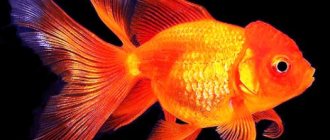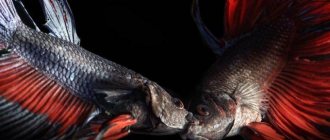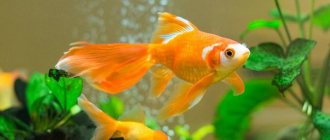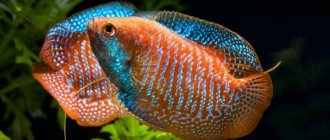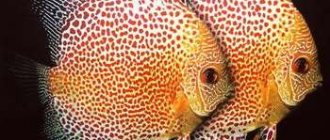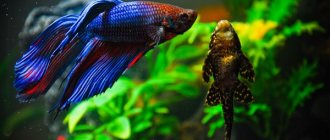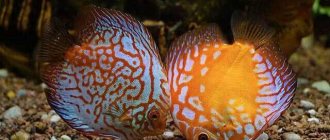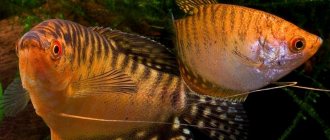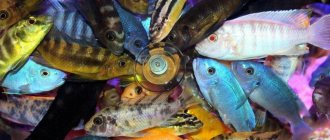Discus. Maintenance in aquarium conditions
Discus fish are characterized by a gregarious lifestyle, so usually 5-7 heads or even more are populated into the aquarium at the same time. They are not aggressive towards other fish, but they can compete with each other. Most aquarium lovers advise providing them with separate maintenance. Some believe that aggression occurs due to the increased temperature characteristics of the aquatic environment. This is not true; it is quite possible to find a large number of species that are ready to enjoy the soft, heated water environment. The risk is that often the same angelfish spread invasions and pathogens that in no way manifest themselves in other fish, but have an incredibly negative effect on discus fish. But this pet is not cheap and requires greater reliability. In addition, some benthic species, especially various locariaceae, who like to rip off secretions from the skin of the flat body of discus fish, often cause significant harm to the fish, leaving scrapings and large spots on the body. It is best to create natural conditions in the aquarium: dim the brightness, glue a black background surface and place a fruit snag in the pond. There is a common belief that there should be no vegetation in a container with discus fish. This is a misconception. It’s just that in a densely planted aquarium environment it is difficult to perform a high-quality siphoning of the soil layer, which can affect the purity of the aquatic environment, to which sumphozodons are so sensitive. It is also necessary to use specialized varieties of aquatic vegetation; they will become filled with greenery and delight the eye even at elevated temperatures. And yet the selection participants are available: Cryptocoryne Bartera, Amazon, Ammania or the magnificent red Barclay. Plants are a natural biological filter and a pleasing pearl for the entire water surface of the aquarium, but you should not overdo it with “gardening”; you need to preserve free spaces for your pets to move freely. Illumination that will suit the vegetation and will not confuse exotic residents is 0.4-0.5 watts per liter.
A large number of different fish representing different families get along well with discus. Let's look at the main ones: Characins (tetras, neons), catfish and dwarf cichlids. Small and schooling representatives of the characin family (for example, Hemigrammus, Hyphessobrycon, Paracheirodon) live in the middle or upper layers of water. When in danger, they hide between plants. Small inhabitants of the upper layers, such as the families of wedge-bellied fish from the genera Carnegirella, Gastropelecus, hide under the leaves of floating plants. Catfish take refuge under roots and stones, near plant stems near the bottom or under tufts of moss.More demanding dwarf cichlids, which have many species. These include Biotoecus, Apistogramma, Apistogrammoides, Crenicara, Microgeophagus, Taeniacara, and others.
Their lifestyle is similar, but may differ.
The most famous dwarf cichlids of South America include species of the genus Apistogramma. Many are found in the same habitat as discus fish, but they are more common. Dwarf cichlids need good hiding places.
Many species of river stingrays also get along well with discus fish.
When setting up an aquarium, you need to think about planning a good shelter for each individual fish (if they need it). To do this, you need to take into account even the smallest details. Only then can the juxtaposition of different fish successfully occur.
The desire of many aquarists to keep not only discus fish in the aquarium, but also other fish, is quite understandable. But when choosing these “settlers”, you should still follow some rules. Since discus belongs to the calmest part of aquarium fish, under no circumstances should nervous or aggressively reacting fish be added to them. Fish that will become neighbors of discus fish should have the same requirements for water quality and temperature as possible.
Now let’s take a closer look at the description of specific fish species that fit the definition of discus neighbors.
Characinaceae
When you think of characins as fish that can be kept with discus, most aquarists think of red neon or similar species. But it should be borne in mind that discus fish will gladly supplement their diet with young fish that are convenient for their small mouths. Unfortunately, juvenile Neons, Rednose Tetras and other fish that are small in size are often added to the aquarium with discus or angelfish and their numbers decrease - they are eaten by larger fish! Therefore, choose not too small representatives of the characin family to be kept together with discus fish.
Suitable species
The species composition of South American characins, which are suitable for keeping with discus fish in the same aquarium, is almost unlimited. These are the following characin genera: Hyphessobrusop
and
Hetigrattus
(characidae family,
Characidae
), of which many beautiful and colorful species are used by aquarium owners.
In addition, certain species from the genera Moen khausia
(tetras /
Characidae), Nematobrus usop
(royal tetra /
Characidae)
and
Paraheirodop
(neon fishes /
Characidae),
as well as
Nannostomus, Core11a, Purhulina,
belonging to the Lebiasinidae family
, are suitable. .
All these small fish, which are 4-5 cm in size, can relatively easily be neighbors of discus fish.
Neon
| Corydoras duplicareus |
Size. Up to 5
cm.
Spreading.
The upper reaches of the Rio Negro (Rio Poranga), in the area of the small settlement of Nobua Oba.
Description.
The painted catfish, like
C. adolfoi,
from the top of the Rio Negro are very noteworthy.
In C. duplicareus
The black stripe on the back especially stands out. It begins at the front of the dorsal fin and extends to the end of the caudal peduncle. There is also a large black stripe running across the eye area. Between both stripes there is an unusual large red-golden spot. The head and body are milky white. Transparent fins have a milky tint.
Temperature.
23-29С
Care.
Sociable small catfish that should not be kept with aggressive fish. Usually relatively unpretentious.
Golden catfish
| Corydoras aneus |
Size. Until 6
cm.
Spreading.
Along the northern part of South America from the island of Trinidad through Brazil to Bolivia.
Description.
According to its wide range, a large number of varieties have been described, which today, however, are considered one species. This species in all variants has a short, rounded head. Most fish have a pattern on their body: from the edge of the gill cover to the end of the caudal peduncle there is a keel-shaped black stripe, tapering downwards. Some varieties, in addition, have a blue, green, reddish, gold or yellow stripe, shimmering with mother-of-pearl, which is located above and sometimes below the black pattern.
Temperature.
22-29C.
Care.
All varieties of this species are easily adaptable, hardy and sociable pets.
Feeding.
Fish do not have any special requirements and willingly consume the types of food offered.
Catfish Agassiza
| Corydoras аgassizi |
Size. Up to 7
cm.
Spreading.
At the mouth of the upper Rio Solimoes (the area of the Brazilian border to Colombia) or the Amazon (Peru).
Description.
The main color of the head and body is whitish-beige. The body is covered with spots of various shapes or small curved stripes (depending on the origin). The abdominal area is without a pattern. The caudal fin has black and white stripes, the dorsal fin is black at the basal part.
Temperature.
23-29C.
Care.
Solid, but always active catfish are ideal pets in a community aquarium, but in a large group they behave with restraint.
Feeding.
Fish should be fed not only with what other fish are fed, but also offered a special meat “delicacy”.
Schwartz's catfish
| Corydoras Schwartzi |
Size. Until 6
cm.
Spreading.
In the lower reaches of the Rio Purus.
Description.
A very commonly imported species of catfish. A notable distinguishing feature of these fish is the two rows of black spots extending above and below the lateral line to the end of the caudal peduncle. There are a number of spots on the dorsal ridge. There is a wide black stripe along the eye area. At the base of the anterior rays of the dorsal fin there is a black spot that extends to the back.
C. parallelus is similarly colored
Temperature.
23-29C.
Care.
Temperamental and hardy aquarium fish. As high as their reproduction rates seem in their natural habitat, their reproduction in an aquarium is so difficult. There is no data on this in the specialized literature.
Feeding.
They do not have any special requirements for food. They eat any food.
Chain catfish
In many community aquariums, as well as in breeding aquariums, two species from the group of small ringed catfish stand out. Some are striking with the “decoration” on the males’ heads in the form of tentacles, others with an unusual zebra pattern. Both species belong to the family Loricariidae,
and rich in genera and species subfamily
Ancistrinae.
Their distinguishing feature is the small hook-shaped spines on their heads. With the help of these devices, catfish are hooked onto the net, if it is not too fine-mesh. (Be careful when catching and replanting!) Animals of both species are active mainly at night and tirelessly absorb food remains, as well as algae, at dusk.
Genus Ancistrus
includes a large number of species (including albino forms), and it is difficult to distinguish them from each other, which, however, is not important when caring for them in a general aquarium. If you arrange tube-shaped shelters that suit their taste, you can expect them to reproduce (at first this happens unnoticed).
Another representative is the zebra catfish Hypancistrus zebra.
Both genera can coexist well with discus fish. The zebra catfish is a somewhat finicky pet. (For more information about the zebra catfish, read the article Striped neighbor Hypancistrus zebra
)
Dwarf cichlids
If you want to keep dwarf cichlids, you should not start with those species that are difficult to keep and that may pose a problem when kept with other fish species.
These fish need caves and similar shelters. Males most often need their own specific territory. They are almost always more intensely colored than females, and they are also larger. In the revere of one male there may be several small zones of influence of females of the same species, which are then considered one large territory of the male, protecting her from the penetration of intruders.
In recent years, new interesting species have appeared. But to keep them in a common aquarium with fish of other species, you should choose only well-known and, above all, hardy fish. They can be purchased in specialized stores, and they are not only inexpensive, which is important when keeping fish of various species in common aquariums, which is always associated with great risk, but they are also unpretentious. Not all spawn in caves, such as species of the most famous genus Apistogramma,
Females of both species of the genus
Microgeophagus, M. ramirezi
and
M. altispinosus,
for example, spawn on flat substrate (rock) outside the cave.
In contrast, females of the genus Dicrossus,
species
O. filamentossus
and
O. maculatus,
lay eggs outside the cave, on a horizontal leaf or root. Laetacara curviceps, from the Amazon region, lays its eggs mainly on stone. Most dwarf cichlids will not eat dry flake food. They need live food, which can be frozen. Feeding small cichlids with Artemia nauplii can be done in small aquariums. Due to the large size of the community aquarium, this is not recommended.
Apistogramma highfin
| Apistogramma eunotus |
Size.
Males up to 8.5 cm, females from 4.5 to 5.5 cm.
Spreading.
Rio ucayali (Pucallpa, Peru) below the confluence with the Amazon (Rio tigre, Rio nanay, Rio yavari, Leticia) to the confluence of the Rio Japura (Lago and Parana do amana).
Description.
The male is larger than the female, the head, body and fins have a strong shine. Fish have good adaptive properties. The main color of the head and body is light beige, overlaid with blue, greenish, pearlescent tones. The tail and anal fin area have a red and blue striped pattern.
Temperature.
25-29C
Care.
The maintenance of this species is relatively simple, so it is good to keep discus as neighbors with an appropriately designed landscape (caves!).
Feeding.
Only live or frozen food.
Apistogram
butterfly (chromis butterfly)
| Microgeophagus ramirezi |
Size.
Males up to 5 cm, females up to
4
cm.
Spreading.
In the middle and lower reaches of the Rio Orinoco (Venezuela) to the delta (between Maturin and Tucupita); in addition, in several areas near Rio Meta (Colombia).
Description.
Males: the head and chest are golden in color. The back of the body of wild fish is clearly blue. Translucent fins with blue spots; Depending on the origin, they may be reddish. The eyes are red, with a stripe. The second ray of the dorsal fin is higher than the others.
Females: a less intense blue color, and especially on the front of the body - an intense golden yellow color.
Temperature.
25-29C.
Care.
Decorate the aquarium with shelters made of driftwood. Animals also seek shelter among plants.
Feeding.
Live or frozen food.
Stingrays
Rays, like sawfishes and sharks, belong to the class Elasmobranchii.
Most of the more than 600 species of stingrays are saltwater fish that live in tropical seas and oceans.
However, several species from the families Rhinobatidae
and
Dasyatidae
have adapted to living conditions in river estuaries, and one of the families of these fish -
Potamotrygonidae
- has mastered the ability to live in completely fresh waters in the northern part of the South American continent.
These are three genera: Potamotrygon
,
Paratrygon
and
Plesiotrygon
, numbering 22 species.
The so-called big-eyed stingrays belong
to the genus Potamotrygon All representatives of this genus are characterized by large, protruding eyes that stick out high above the surface of the body. The length of the tail of these fish is equal to or slightly greater than the diameter of their body. The most commonly kept species in aquariums are Potamotrygon motoro
,
P. hystrix
,
P. reticulata
and
P. leopoldi.
In addition to them, this genus also includes:
P. garrapa, P. dumerilli, P. henlei, P. orbignyi, P. magdalenae, P. brachyura, P. constellata, P. ocellata, P. humerosa, P. scobina, P signata, P. schroederi, P. falkneri, P. menchacai, P. castexi
and
P. yepezi.
Skat motoro
| Potamotrygon motoro |
Size.
up to 50 cm.
Spreading.
Almost all of South America. Peru, Colombia, Venezuela, Brazil and Argentina Description. Dark gray to reddish beige color. The diameter of the circles in the figure is about 3 cm, arranged irregularly, in most cases mirror-distorted; near the edge the circles are smaller. Dots from white to orange. They partially have multi-colored rings, the number of which varies from animal to animal.
Temperature.
24-30C.
Care.
In nature, they live in soft water, so for a newly acquired stingray from nature, the water should not be harder than 5°dGH. Water hardness can be increased only after adaptation, and very gradually, but not more than up to 18°dGH. pH from 5.0 to 8.0.
Feeding.
Suitable food: bloodworms, tubifex, finely chopped fish fillets, small shrimp, krill, live fish
Discus Contents
There was an opinion that discus fish are very finicky and difficult to keep in an aquarium. In fact, all problems can be easily solved; the main thing is to find out in time what conditions to create for these beautiful fish. You need to select a suitable aquarium based on the number of fish - it is desirable that the discus have enough space for swimming. For an adult, at least 40 liters are needed. The width of the aquarium should be at least half a meter. The tank must be maintained at a constant temperature of 28 to 35 degrees - discus fish are thermophilic.
For representatives of this species, adequate lighting is very important. As for the soil, its presence is not necessary, since it makes cleaning the aquarium much more difficult
Plants need to be selected correctly, since at such high temperatures they will require intense lighting. This can be Cryptocoryne, Amazon broadleaved, horizontal Echinodorus, dwarf Amazon, floating horn fern, Riccia fluitans, Java moss and others. You can also use stones, driftwood and grottoes as decorative elements.
The aquarium must have constant filtration; you can install ozonizers or ultraviolet light to purify the water from harmful microorganisms. You need to change 30-40% of the water regularly; on special discus farms, specialists change up to 90% of the water per day. As for the acidity of the water, you need to maintain it at a level of 5.5-6.5 pH. The temperature should not fall lower than 27 degrees, you need to be especially careful when transporting fish - a small mistake can cause the death of discus.
Most aquarists agree that discus should not be fed with live food; the same bloodworms or tubifex can become a source of disease. To feed individuals, live food is frozen, after being treated with a formaldehyde solution and washed thoroughly. You can also feed discus fish with homemade food made from a mixture of shrimp meat and beef heart. Ready-made dry food is sold in pet stores, but is not cheap. If possible, you need to diversify the diet of the inhabitants of the aquarium - add plants (kamomba, hygrophila, limnophila) to their food, which the fish will pluck, and dry fortified food. Adult fish are fed three times a day, fry up to 6-8 times a day.
Probable neighbors
Neons, angelfish, mollies, and swordtails will be good neighbors. The only problem is that the temperature maximum for some coincides with the minimum for others. That is, the temperature should remain within 28-29°C. Any deviation will lead to the death of one of the inhabitants.
Possible neighbors also include species that can withstand water parameters, but have a quarrelsome character or bad habits. For example, peaceful loricaria are compatible with discus fish, but can deprive their offspring of food: they eat nutritious secretions on the body of an adult, leaving the fry without food. Moreover, sometimes loricaria cause serious injuries to parents, leading to illness or death.
Diet choice can also be a problem. “Kings,” like any artificially bred species, have weak immunity. Even the live food that is fed to their neighbors in the aquarium can pose a danger to them.
If you have at least a couple of discus fish, you need to choose only proven and safe food from well-known brands. For example, the German brand Discusfood, “tailored” for these pets.
Keeping discus fish in an aquarium
Discus fish photo
Discus fish content photo
Discus fish are one of the most difficult tropical fish to keep and are not recommended for beginner aquarists. One of the most difficult stages of keeping discus fish is the process of their acclimatization in a new aquarium. And due to their large size, it is worth acquiring a large aquarium in advance so as not to further injure the fish during transplantation.
To keep discus fish, you need a large aquarium with a capacity of at least 50 - 80 liters per individual with good water flow and effective filtration. Fish prefer warm, soft, slightly acidic water, which can often be achieved by using a reverse osmosis filter. And in aquariums with live plants, it is recommended to install a carbon dioxide supply.
Some aquarists place discus fish in aquariums with a bare bottom (without substrate) and consider this method of keeping to be the best, although not very beautiful.
The absence of a substrate makes it easy to clean the tank from feces and rotting debris. This is a good way to keep the water quality stable and perfect.
Since discus are a schooling fish, they need to be kept in a group of at least 6 individuals.
Unlike many members of the cichlid family, discus fish are peaceful fish. Representatives of the Characin species (neon tetras, cardinal tetras, ember tetras, harlequin tetras and rummynose tetras), dwarf cichlids, ancistrus, angelfishes (angelfish) are suitable as neighbors. At the same time, you should refrain from being close to Corydoras Catfish, because these fish are prone to carrying internal parasites and can infect discus fish.
Discus fish are very shy fish. They feel comfortable in secluded corners, densely planted with plants, which in turn should have water parameters similar to those of discus fish (Vallisneria, Nymphea tiger, Anubias, Echinodorus, Ambulia, Schisandra, Thai fern, Hornworts, etc.).
Remember, discus are very sensitive to fluctuations in water parameters and even small amounts of nitrates and ammonia. Maintaining the required water parameters is the key to a long life for fish!!!
What food is best for discus fish?
One of the conditions for survival in a community aquarium is the right choice of food. Mixtures of unknown composition or live food purchased from a dubious place can nullify all the efforts of the owner. Pets easily catch diseases and can die in a matter of days from the slightest infection.
The German company Discusfood guarantees the quality of its products. The mixtures contain useful additives, vitamins, natural protein products, and fiber.
- Due to their consistency, Grand Champion soft granules are suitable even for the smallest fish.
- Turkey Heart food can serve as a sole food source. The composition includes all the necessary mineral and vitamin supplements.
- The Artemia 50% Softgranulat mixture contains chitin, which works as a natural soft sorbent.
Discusfood products do not require pre-treatment (soaking, defrosting) and do not clog filters or the bottom.
Discus diseases
The main reason for their occurrence is non-compliance with maintenance rules
With good care, when attention is paid to the quality of water, lighting and nutrition, stress (the cause of many diseases) is practically eliminated. Discus fish are aquarium fish that are very sensitive to even minor changes.
Main problems faced:
- Intestinal diseases. The cause may be poor quality food or a sick neighbor. The fish becomes lethargic and refuses to eat. The excrement looks like white threads. Purulent ulcers appear on the head and fins. An accurate diagnosis can only be established through laboratory testing.
- Intestinal obstruction, dropsy. They arise as a result of poor nutrition. The fish's abdominal cavity is swollen, and its eyes may be bulging. In the first case, the discus takes food until the intestines rupture, after which it dies. Dropsy is characterized by a complete lack of appetite.
- Bacterial infection. The symptoms of this disease cannot be ignored - the edges of the fins turn white, the mucous membrane thickens, the color of the body becomes darker. The fish loses its appetite and hides in a corner. If rescue measures are not taken in time, its eyes gradually become cloudy, and its fins and tail begin to decompose. Treated with antibiotics.
- Parasitic diseases and fungal infections are common in discus fish.
- Gill and skin fluke worms can lead to a very serious condition for fish. Special products sold in pet stores help in the fight against them.
Editorial: Hottonia palustris
What to feed
Discus fish can be fed live food, frozen food, or homemade minced meat. Each of these types of nutrition has its pros and cons.
These fish themselves prefer live food. But the problem is that giving it is sometimes dangerous, because it is with live food that pathogens and parasites enter the aquarium. If you decide to give them bloodworms, then you need to find a trusted supplier. The bloodworm itself must be treated for infections. Only dry food is contraindicated for these fish.
Frozen food should have a normal smell. Watch the expiration date carefully. If it is a bloodworm, then after defrosting it should be elastic and red.
The ideal option is homemade minced meat made from beef heart. For example, here is one of the possible recipes:
- Beef heart (without veins) – 200 g.
- Low-fat sea fish – 200 g.
- Shrimp (small ones don’t need to be peeled) – 200 g.
- Squid (before adding to the minced meat, you need to remove the skin and pull out the backbone) – 200 g.
- Frozen bloodworms – 200 g.
- Frozen artemia – 200 g.
- Spinach leaves, parsley (pre-scald with boiling water).
- Juice of one carrot (vitamins can be dissolved in it).
All this is thoroughly ground in a blender (except for bloodworms and brine shrimp). You can add medications to the minced meat if necessary. You can add half a glass of spirulina and dry food.
Healthy individuals always eat food with great appetite. If your discus refuses to eat, there is a good chance that they are sick.
Features of keeping discus fish
Discus fish are quite whimsical, and their maintenance requires certain strict conditions. First of all, when purchasing these fish, you need to provide them with easy acclimatization to a new place. Since the fish are schooling, it’s worth buying several of them. But even compliance with all the conditions does not guarantee trouble-free placement of discus in a new home - the fish are not at all stress-resistant.
In the photo there is a discus leopard fish
One of the main requirements for keeping discus fish is a large aquarium volume. Since these fish are quite large and inhabit them in groups of six or more individuals, there should be enough space for them - from 250 liters of water. The height of the aquarium must be at least 50 cm and the width at least 40 cm.
Narrow screen aquariums are not suitable, since an adult discus simply cannot turn around normally in them. As for the requirements for the water itself, it is better to use the water that comes from your tap, letting it sit for 48 hours to remove free chlorine.
Many people believe that since discus live in soft water in nature, then the aquarium should have the same. But, firstly, this creates certain difficulties with replacement, because you need to replace at least 30% of the water with clean water weekly, and secondly, hard water is even safer - parasites that are destructive to discus fish do not survive in it.
Pictured is a discus diamond
But the fish themselves feel quite fine at a pH of more than 8.0. In addition, it is easier to provoke fish living in such water to reproduce by making the water soft and creating other necessary conditions. As for the water temperature, it should be at least 29C⁰.
Another important condition for keeping discus fish is the cleanliness of the aquarium. From compliance with this parameter, several more requirements follow: refusal of plants inhabiting the aquarium, constant (preferably after each feeding) cleaning of the soil or abandonment of it, installation of a good water filter
An important factor in the successful keeping of discus fish will be to ensure they have a quiet life; you should not traumatize the weak psyche of these fish with loud sounds, knocking, or sudden movements. Therefore, it is better to place the aquarium in a quiet, secluded place, where there is enough diffused light, but there are no bright sunlight.
In bright light, discus fish will constantly feel discomfort. The bottom of the aquarium should also be dark. You can use high-quality plastic driftwood, branches, and plants as decoration. Discus fish love to hide in various shelters and stand under tree branches.
Neighborhood
Discus fish are very specific fish; the conditions suitable for them are quite difficult for other representatives of the southern world to tolerate. In the best case, this may be the same tropical inhabitants with a similar habitat, for example, various small representatives of the Characinidae: tetras or neons.
Discus fish have no equal in their peacefulness and non-conflict nature, so smaller fish are in no danger. But angelfish, which have a similar shape to discus fish and are often recommended for keeping together, require increased attention: their more aggressive nature can cause discus stress.
Ultimately, due to intraspecific diversity, discus can become the only inhabitants of the aquarium without making it boring.
Discus breeding
Discus fish belong to spawning fish, and their reproduction has a number of features. The fish become sexually mature at the age of 1.5 to 2 years, and can reproduce for only 2-3 years.
Like many fish that lay eggs, discus form a stable pair from an early age. If spawning occurs between fish of different colors, then the offspring will surprise with their colors. New and unusual varieties of discus are obtained spontaneously without much difficulty.
For breeding, it is better to purchase a flock of several fish. In such an environment, the resulting pair will soon become noticeable. Prospective breeders are placed in a separate container with a volume of 100 liters or more, in which various decorative items (stones, driftwood, ceramic shards) are placed. The spawning tank is not placed in the light; lighting should be around the clock, but dim
The couple is protected from stress; the water in the aquarium is changed frequently, but very carefully. The optimal temperature for reproduction should be from 28 to 30 degrees
It is important to monitor the water hardness: the water should be soft. In very hard water, egg fertilization may not occur.
Discus fish begin to spawn in the late afternoon. Before this, they begin to clean the spawning area and twitch their fins. The eggs are laid on a large leaf or any smooth surface in the aquarium. At one time, the female produces 200-400 eggs. The clutch is immediately fertilized by the male.
On the 3rd or 4th day the fry appear. Over the next 4 days they begin to swim. In the first days of life, babies are fed with a special secretion that is secreted on the skin of their parents. Both parents take part in feeding: as soon as the skin secretions end on the skin of one fish, another approaches. The babies feed like this for 2 weeks, after which the adult fish are transplanted into a common aquarium.
How does spawning happen?
Discus spawning usually occurs in the evening or at night. After a short courtship, the couple begins to clean the surface on which they will lay eggs. Over a short period of time, the female lays up to 300 eggs. Next, care for future offspring passes to the male. It seems to hover over the eggs and constantly fan them with its fins; occasionally the female can replace the male for a while; even more rarely, both parents fan the eggs together. Why are they doing this? So that the masonry is washed with clean, oxygenated water.
Video: Discus Spawning
If all the requirements for water quality are met, then after a few days the eggs will begin to darken, and on the third day fry will appear from the eggs. After all the larvae are born, the parents move them to another place. This happens within 2 days, usually in 4-5 times all the fry will be transferred to a clean space.
Whenever possible, it is necessary to remove whitened eggs from the clutch - they are spoiled and can cause infection.
The next stage will be the moment when the babies attach to the body of their parents and begin to feed on mucous secretions from the skin of adults. At this time, the whole family needs complete peace. You should close the walls of the aquarium or darken them in advance.
If suddenly the babies are not attached to their parents, but are swimming all over the aquarium or huddled in a flock somewhere in the corner, then most likely all the offspring will die. Within the scientific community, there are cases of obtaining healthy specimens of discus fish raised artificially - without the participation of parents. At home, this task is almost impossible to accomplish.
During the period when parents feed their babies, discus pups do not need additional nutrition, and their parents eat much less than usual. It is recommended to feed adults in small portions . If you neglect this rule, the water can quickly become dirty due to excess food, and this is extremely undesirable for discus fish - they can get sick or die. In addition, you should avoid coretra and bloodworms as food during this period - they will irritate young parents with their behavior in water.
A couple can feed their offspring on their own for a week, without compromising their own health, but then the fry need additional feeding.
Biotope
The biotopes of the Amazon basin undergo significant changes throughout the year. With the onset of the rainy season in December, the Amazon floods. Tropical rainfall and meltwater from the highlands raise the water level in the river bed. At this time, the water in many tributaries reverses its flow direction until the overflowing river floods vast areas. Floods bring muddy clay water to reservoirs with crystal clear water. The flooded forest surrounding the Amazon is turning into a single, slow-moving swamp. By May the heavy rains stop. River water stops flowing into the waters of the flooded forest and they gradually become transparent. From July onwards, the water level drops significantly for several months. Many isolated reservoirs and small streams appear, in which the water acquires purity and a characteristic dark color. Water parameters in such reservoirs can reach extreme values of softness, lack of electrical conductivity, and sterility. According to H. Blecher, discus live in “black” water among thickets of coastal bushes, where the bottom of reservoirs is covered with a layer of rotting leaves. The water is very soft and quite acidic. The roots of coastal vegetation are under water most of the year and serve as shelter and substrate for spawning. As the water level decreases, the fish leave their shelters and go deeper, to the center of the reservoirs.
Editor's note: Oliver Knott, who is he?
Discus fish are not found in large rivers and are rarely found in areas of intense currents, inhabiting many small tributaries and streams. Thus, the difficult movement of isolated populations leads to the formation of characteristic features (primarily coloration) even for relatively small isolated groups. Such local populations can number several hundred individuals, exhibiting signs of schooling fish behavior.
In nature, the diet of discus fish consists of insect larvae and freshwater shrimp.
Tips for choosing
You should only buy discus fish from a trusted store. It is better to observe them for several days before purchasing. First of all, you need to pay attention to their appearance - they should not be thin and pale.
You need to pay attention to the eyes - they should not be cloudy. The gill covers should not protrude, without deformation.
How to keep and care for discus fish
All discus are very peaceful and calm fish that eat slowly and live in warm water, compared to many aquarium representatives. This creates certain difficulties for other species to colonize them. Discus fish live in groups of 6, so the best option for keeping them is a species aquarium.
Only a person who has been working with aquarium fish for a long time will be able to create ideal conditions for the habitat of this species and get offspring from them. Frequent problems in keeping discus fish are their susceptibility to disease and the resulting stress when moving. These factors should be taken into account in advance: choose the right food and a comfortable aquarium with a suitable water temperature.
We will create optimal conditions
The most important requirement will be to populate a flock of at least 6 pieces. The size of the discus suggests that the aquarium will need 200-250 liters. They do not do well alone, so keeping them in a pack will be the first step to success.
It is also necessary to highlight the following care recommendations:
- Pure water. Up to 30% of the water should be changed per week.
- The soil may not be used if plants are planted in the future.
- Plants are needed to absorb organic matter from water. Thus, they significantly improve the habitat for discus fish.
- Lighting should not be bright.
- Filtration required. The choice of external or internal device depends on convenience and specific cases.
Water purification is carried out using ultraviolet radiation, and for experienced aquarists it is recommended to use ozonation. For fish lovers who can afford high costs, it is recommended to purchase high-tech equipment, consisting of complex filters and various devices for monitoring and testing water characteristics.
Compatibility with other fish
Despite their belonging to cichlids, discus are distinguished by their peaceful disposition and friendliness. However, this does not mean that it is easy for them to choose suitable neighbors.
The main difficulty in selection lies in the characteristics of the fish itself:
- They require high temperatures , unsuitable for most aquarium inhabitants.
- Discus fish are very timid and skittish.
- They have weak immunity.
- They eat very slowly and often other fish take their food away from them.
For these reasons, it is recommended to keep discus fish in a separate species aquarium.
But if you still decide to keep discus fish together with other species, then it is recommended to choose representatives of the aquatic world that are similar in temperament. The following fish are acceptable:
- cardinal tetra;
- Botia macracantha;
- rhodostomus;
- tetra congo;
- golden parrot;
- chromis butterfly.
Tetra Congo
Avoid large aggressive fish (cichlids, piranhas), catfish with horny suckers (ancistrus, hypancistrus) and corydoras.
How to properly decorate an aquarium
How the fish will feel in it, their health and reproduction depends on how well the aquarium is designed.
The main and most important factor is the water temperature, which should be around 30°C. This also becomes the main argument when choosing plants that will be placed in an aquarium, since not all of them can grow at this temperature, so high-quality artificial plantings are usually used.
In addition, this species simply requires the presence of driftwood or a large grotto for shelter. Ash, alder or maple are perfect. Avoid introducing resinous trees and oak into the aquarium.It is worth paying special attention to lighting, especially if there are live plants in the aquarium. Since discus do not like bright light, there may simply not be enough light for the plants.
The way out is to create special darkened areas.
Soil selection
Particular attention should be paid to the soil, as it:
- Gives the aquarium individuality and attractive appearance;
- Serves as a filter into which various microparticles fall (be sure to include bottom snails in the discusser);
- Creates conditions for the proliferation of necessary bacteria and fungi;
- Maintains biological balance.
The best soil to place in an aquarium is sand or gravel, laid in a thin layer.
An ideally selected soil should not contain admixtures of various rocks or minerals, as they may contain substances that will cause fish poisoning. Quartz soil is excellent - it is neutral and will cause harm. Sometimes soil is not used at all, as it complicates the cleaning process. And a high degree of water purity is vital for discus.
Aquarium equipment
Sharp changes in temperature are contraindicated for fish that live in subtropical climates; to maintain the required parameters, it is necessary to use an aquarium heater. It’s easy to use – you just need to set the required temperature. The heater will heat up to the set parameter and keep the water optimally warm.
The following equipment is also required:
- Internal filter – necessary for purifying water in a small aquarium;
- An external filter is worth purchasing if the aquarium volume is more than 300 liters. This filter is well suited for an aquarium with discus fish, because it does not create a current;
- Compressor – serves for aeration of water;
- Aquarium lamp – properly selected artificial lighting will help create a cozy, comfortable atmosphere;
- An ultraviolet lamp is necessary to purify water from harmful microorganisms.
Characteristics of the species and color
This type of aquarium fish is quite large in size and reaches 15-20 cm, has a flat round body and is a schooling species. The fish belongs to the cichlid family and has a bright color. A characteristic feature is dark vertical stripes located throughout the body, with the exception of the thoracic region.
The head and mouth of the fish are relatively small in size, and the eyes are large and protruding, often red. The fish has modest fins. Color always depends on the breed.
The natural form is modest brown with various shades, while the selection forms range from bright blue to white with red speckles.
The color depends on the type of discus, but can vary depending on the condition: during illness, the color becomes very pale, and when the fish is nervous, the stripes acquire a bright shade.
Description of the breed
Discus is a large fish with a disc-shaped body. The length of individuals varies from 15 to 25 cm and depends on what variety they belong to. If you compare it with other cichlids, you will notice that discus fish have compressed sides, more than others, and because of this feature the fish got their name.
Today there are many species that differ from each other in color; it is quite difficult to describe them all. In addition, the variety of colors is truly amazing. But the most popular are the following breed varieties:
- Pigeon blood is a Thai hybrid obtained by crossing the turquoise striped discus and the red turkis. The main color of the scales is white, with longitudinal red stripes in the form of waves. The fins are also decorated with stripes - red and white. Another feature of pigeon blood discus is its red eyes.
- Pigeon is a fish whose eyes resemble blood-red rubies. Earlier individuals were covered in pigmented black spots, but through selective breeding they were bred out. The color of the pidgeons has become more harmonious and uniform.
- Blue diamond - the body of the fish is tall, round, strongly flattened. Wild individuals have an even, pale bluish coloration and red eyes. They were actively used in breeding work, and they gave rise to many breed varieties. Among the aquarium representatives there are both plain blue fish and those with blue scales.
- Snakeskin is a fish with an extravagant color: its light body is covered with a large number of small red specks, which makes it look like the skin of a snake. The fish was bred in Thailand, based on the blue discus.
- Leopard - these individuals were the result of crossing a green discus and a red turkis. The original leopard coloring was formed from red spots scattered on a white background. These are large representatives of the species, growing up to 20 cm. “Leopards” have one feature - they are sensitive to lighting.
- Heckel's discus - has a calm, beige-pink color with turquoise stripes. There are vertical dark stripes around the body, the eyes are black-brown and practically do not stand out.
- Green discus is a fish with a greenish-brown body decorated with 9 dark stripes. Horizontal lines of turquoise color are located horizontally, they converge in the abdomen area, creating a solid color scheme. The color is not permanent and can vary from yellow to reddish hues.
- Cobalt - individuals have a blue body covered with stripes; this variation is considered classic. Often there are fish with a stripe running along the line of the eyes. With age, the stripes gradually fade and disappear.
- Marlboro Red - the color of the fish contains red or orange tones, there are several white stripes.
From the editor: =Treatment and diseases of aquarium fish=
This is only a small part of the discus species. Modern breeders never cease to amaze, producing fish with brighter and more unusual colors. For example, you can find the “pigeon blood” species with the “checkerboard” color, “golden melon” discus, “golden albino”, “super red passion” and others.
But selective crossbreeding, although it made the fish unusually beautiful, had a negative impact on their immunity, weakening it. Their wild counterparts are stronger and more unpretentious.
History of the species
Now, all over the world there are nurseries where these magnificent fish are bred. They attract with their amazing coloring, which was bred by breeding scientists from Japan and China, America and other countries; and has more than 20 different colors. But initially there were only a few varieties of their natural color.
The fish got its name, which comes from the Greek discus, due to its unusual shape, which resembles a disk. The first descriptions of this species appeared back in 1833, and by 1960, American ichthyologists began seriously selecting this breed, which attracted the interest of a large number of fish breeding enthusiasts. Discus fish were brought to the territory of the USSR in the mid-60s of the last century.
Features of character and lifestyle
Photo: Discus
Discus fish are relatively calm fish. They have a calm character. In nature they live in isolated flocks. One such flock can number up to several hundred individuals. There are usually no conflicts in a flock, except that males may quarrel over a female. Sometimes during the breeding process, the male and female may quarrel with each other. If at that moment they have eggs already laid, they can eat them.
In nature, fish live in small warm ponds and streams with diffused light, warm water and plenty of hiding places. These fish are afraid of loud sounds and sudden movements. Stress has a bad effect on fish, they change their color and feel bad. Next to Symphysodon discus in nature you can find such fish as Cyclidae of various genera, knifefish, catfish, stingrays and piranhas.
In terms of proximity to other fish, discus are not aggressive, and there are no fights for territory. And many other fish will not live in the area occupied by discus fish due to the fact that the water there is too warm and soft. In ordinary life, fish live in schools. Such flocks are usually not clearly formed. During spawning, fish are divided into pairs consisting of a male and a female. Fish spawning occurs in secluded places among the flooded roots of bushes and various plants.
In captivity, these fish are often kept in large, isolated aquariums. Discus fish of all types are quite safe for neighbors, but other fish cannot get along with them because of their heat-loving nature. It is not advisable to plant discus fish together with aggressive angelfish and other fish, otherwise the angelfish may begin to terrorize them and tear off the fins of calm discus fish.
Natural habitat conditions
In nature, this species lives in Brazil and South Africa. The fish likes to be in small tributaries and streams with a slight current, and often hides among the roots of trees and bushes.
The climate of the natural habitat is quite hot, the temperature very rarely drops below 23°C.
Breeding discus at home requires maintaining a constant temperature and carefully ensuring that the water is clean and sufficiently hard.
Getting offspring
Sex differences are subtle and appear only during spawning. The male has a steeper forehead and thicker lips. Also at this time, females develop a trapezoidal ovipositor, and males develop a conical vas deferens.
Discus fish form monogamous pairs that last their entire lives. In order to form such a pair, they acquire a flock of 6-8 individuals, allowing them to independently choose a partner. After the fish find the other half, they will swim one after another in single file and try to stay together.
As soon as the fish begin to prepare for spawning, they are placed in the spawning tank. The water in it should be warm, very soft and acidic. It should also be equipped with ultraviolet sterilizers that destroy pathogenic microorganisms to which discus eggs are not resistant. The incentive for spawning is to increase the frequency of water changes, raise it by a couple of degrees, and also increase the proportion of high-protein feed in the diet.
The female lays eggs on a vertical surface, which is carefully cleaned by her partners. At this time, the fish may show aggression and drive neighbors away from their territory.
After all preparations have been made, the female lays eggs in rows, which are immediately fertilized by the male. Incubation of eggs at a temperature of 30°C lasts about two days, after which the larvae hatch. Throughout this time, the parents look after the clutch, fan it with fins and remove dead eggs.
At first, the fry are fed with skin secretions from the sides of their parents. Sometimes it happens that this mucus is not enough. And then a conflict arises between the adults for the right to feed. In such fights, even fry can be eaten. To protect them, separator nets are installed, which allow the fry to swim through, but adults are not allowed to eat them.
Grown-up fish are removed and fed with naupli of cyclops, brine shrimp and egg yolk. Basic conditions for caring for juveniles: feed regularly and often for uniform growth and change water. For up to 1.5 months, the fry are left with light at night so that they can easily find food. They are fed every 2 hours. Teenagers are given food a little less often - 6 times a day. Adult fish are fed 3 times a day.
Seventeen-day-old discus pups.
Feeding
Quite picky. In the natural environment, they feed on underwater insects and their larvae, but species artificially bred in aquariums are more picky about food and will not feed on bloodworms, brine shrimp or tubifex.
Discus breeders prepare special minced meat to feed their pets. Each experienced aquarist has his own recipe. The main thing is that it contains all the necessary microelements and vitamins that are present in balanced dry food. It is most often made from hearts (beef or chicken), seafood (mussels, fish meat), vegetables (carrots, cucumbers) and herbs. Live and frozen ingredients can be used.
View this post on Instagram
#Symphysodon #Symphysodon_discus #Discus #Discus
A post shared by ?? ??? ????????? (@scipio_0019) on Apr 2, 2015 at 1:30am PDT
Feeding is done twice a day, but discus can tolerate no food for 1-3 days. Remains of food after feeding are immediately removed from the water.
